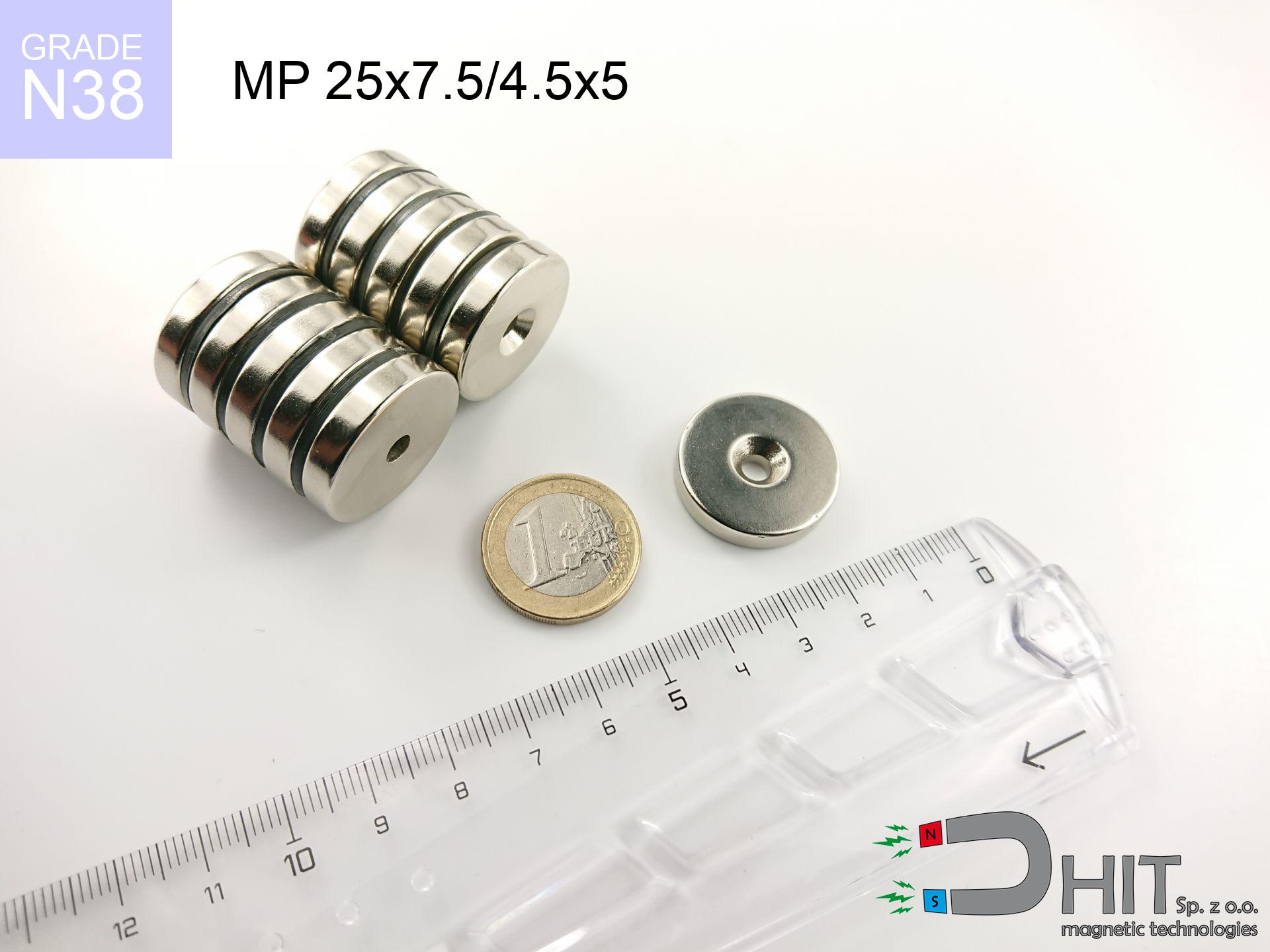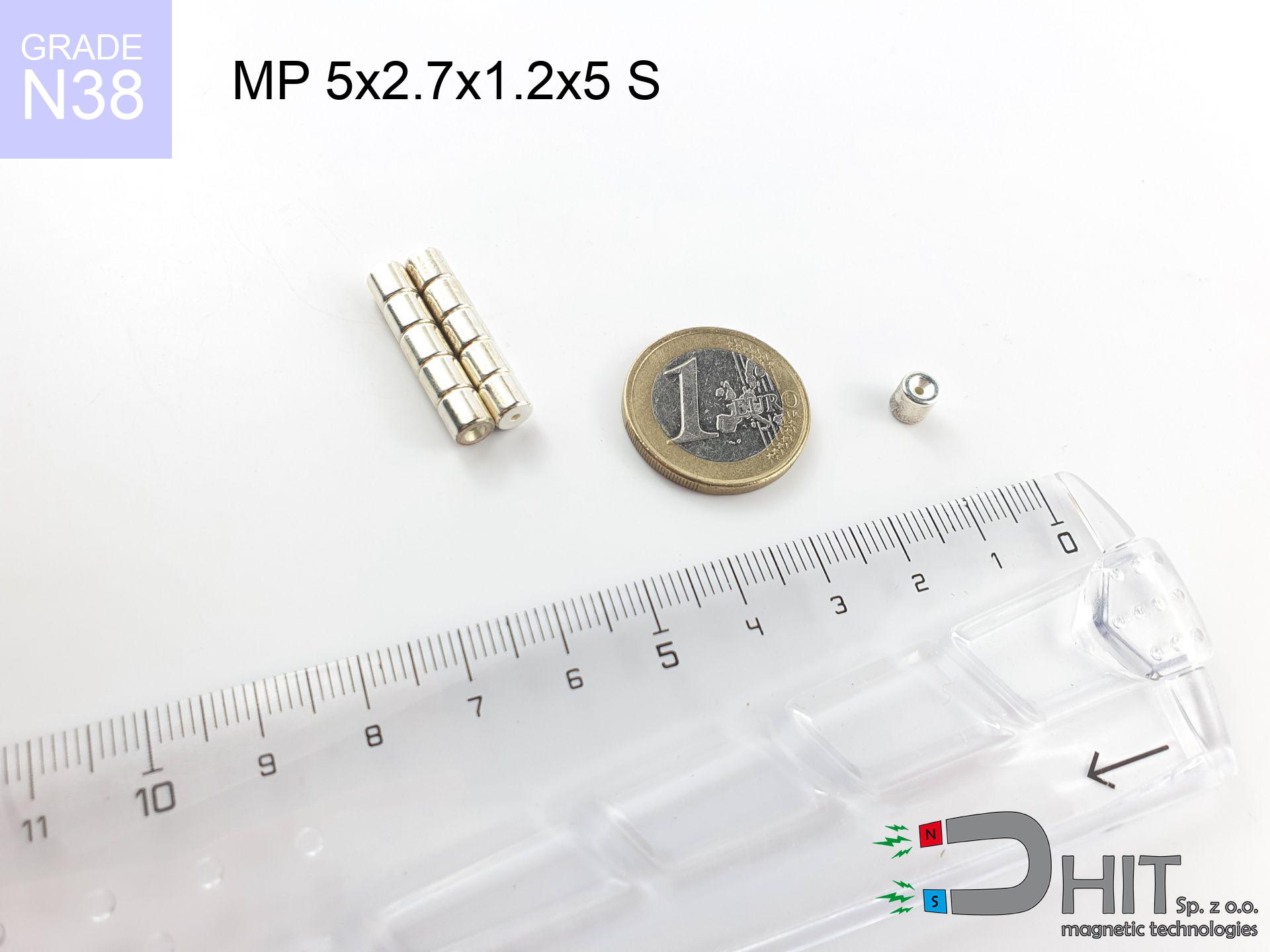MP 25x7.5/4.5x5 / N38 - neodymium magnet
ring magnet
catalog number 030194
GTIN: 5906301812111
external diameter Ø
25
mm [±0,1 mm]
internal diameter Ø
7.5/4.5
mm [±0,1 mm]
height
5
mm [±0,1 mm]
magnetizing direction
↑ axial
capacity ~
1.71 kg / 16.77 N
magnetic induction ~
333.60 mT / 3,336 Gs
max. temperature
≤ 80
°C
catalog number 030194
GTIN: 5906301812111
external diameter Ø
25 mm [±0,1 mm]
internal diameter Ø
7.5/4.5 mm [±0,1 mm]
height
5 mm [±0,1 mm]
magnetizing direction
↑ axial
capacity ~
1.71 kg / 16.77 N
magnetic induction ~
333.60 mT / 3,336 Gs
max. temperature
≤ 80 °C
8.00 ZŁ gross price (including VAT) / pcs +
6.50 ZŁ net price + 23% VAT / pcs
bulk discounts:
need more quantity?Want a better price?
Give us a call tel: +48 888 99 98 98 or get in touch through form on our website. You can check the mass and the shape of neodymium magnet in our power calculator power calculator
Orders placed by 2:00 PM will be shipped on the same business day.
Specification: ring magnet 25x7.5/4.5x5 / N38 ↑ axial
Magnetic properties of the material N38
Physical properties of sintered neodymium magnets Nd2Fe14B
Find suggested articles
Advantages as well as disadvantages of neodymium magnets NdFeB.
In addition to immense strength, neodymium magnets have the following advantages:
- They do not lose their strength (of the magnet). After about 10 years, their power decreases by only ~1% (theoretically),
- They are highly resistant to demagnetization by external magnetic sources,
- In other words, thanks to the shiny nickel, gold, or silver finish, the element gains an aesthetic appearance,
- They have very high magnetic induction on the surface of the magnet,
- Magnetic neodymium magnets are characterized by very high magnetic induction on the surface of the magnet and can operate (depending on the shape) even at temperatures of 230°C or higher...
- The ability for precise shaping and customization to specific needs – neodymium magnets can be produced in various forms and dimensions, which amplifies their universality in usage.
- Key role in modern technologies – are used in hard drives, electric motors, medical apparatus or other highly developed apparatuses.
Disadvantages of neodymium magnets:
- They are fragile when subjected to a strong impact. If the magnets are exposed to impacts, we recommend using magnets in a metal holder. The steel housing in the form of a holder protects the magnet from impacts and at the same time increases its overall strength,
- Magnets lose their strength due to exposure to high temperatures. In most cases, when the temperature exceeds 80°C, these magnets experience permanent reduction in strength (although it is worth noting that this is dependent on the shape and size of the magnet). To avoid this problem, we offer special magnets marked with the [AH] symbol, which exhibit high temperature resistance. They can operate even at temperatures as high as 230°C or more,
- Magnets exposed to a humid environment can corrode. Therefore, when using them outdoors, we recommend using waterproof magnets made of rubber, plastic, or other moisture-resistant materials,
- The use of a cover or a magnetic holder is recommended due to the limited possibilities of manufacturing threads or complex shapes in the magnet
- Possible danger arising from small pieces of magnets can be dangerous, in case of ingestion, which is particularly important in the context of children's health. Furthermore, tiny parts of these magnets have the potential to be problematic in medical diagnosis in case of swallowing.
Handle Neodymium Magnets with Caution
Neodymium magnets are among the strongest magnets on Earth. The astonishing force they generate between each other can surprise you.
To use magnets properly, it is best to familiarize yourself with our information beforehand. This will help you avoid significant harm to your body and the magnets themselves.
Do not bring neodymium magnets close to GPS and smartphones.
Magnetic fields can interfere with compasses and magnetometers used in aviation and maritime navigation, as well as internal compasses of smartphones and GPS devices. There are neodymium magnets in every smartphone, for example, in the microphone and speakers.
Neodymium magnets can attract to each other, pinch the skin, and cause significant injuries.
Magnets will crack or alternatively crumble with careless connecting to each other. Remember not to approach them to each other or have them firmly in hands at a distance less than 10 cm.
Neodymium magnets can demagnetize at high temperatures.
Even though magnets have been observed to maintain their efficacy up to temperatures of 80°C or 175°F, it's essential to consider that this threshold may fluctuate depending on the magnet's type, configuration, and intended usage.
People with pacemakers are advised to avoid neodymium magnets.
In the case of neodymium magnets, there is a strong magnetic field. As a result, it interferes with the operation of a heart pacemaker. However, if the magnetic field does not affect the device, it can damage its components or deactivate the device when it is in a magnetic field.
It is essential to maintain neodymium magnets away from youngest children.
Remember that neodymium magnets are not toys. Do not allow children to play with them. In the case of swallowing multiple magnets simultaneously, they can attract to each other through the intestinal walls. In the worst case scenario, this can lead to death.
Dust and powder from neodymium magnets are highly flammable.
Avoid drilling or mechanical processing of neodymium magnets. Once crushed into fine powder or dust, this material becomes highly flammable.
Keep neodymium magnets away from TV, wallet, and computer HDD.
Neodymium magnets produce intense magnetic fields that can damage magnetic media such as floppy disks, video tapes, HDDs, credit cards, magnetic ID cards, cassette tapes, or other devices. They can also destroy devices like video players, televisions, CRT computer monitors. Remember not to place neodymium magnets close to these electronic devices.
Magnets made of neodymium are fragile and can easily crack as well as get damaged.
In the event of a collision between two neodymium magnets, it can result in them getting chipped. Despite being made of metal and coated with a shiny nickel plating, they are not as hard as steel. At the moment of collision between the magnets, small sharp metal fragments can be propelled in various directions at high speed. Eye protection is recommended.
If you have a nickel allergy, avoid contact with neodymium magnets.
Studies show a small percentage of people have allergies to certain metals, including nickel. An allergic reaction often manifests as skin redness and rash. If you have a nickel allergy, you can try wearing gloves or simply avoid direct contact with nickel-plated neodymium magnets.
Please read the article - What danger lies in neodymium magnets? You will learn how to handle them properly.







![search holder 94x40 [3xM10] GW F550 Silver Black Lina / N52 ↑ axial search holder 94x40 [3xM10] GW F550 Silver Black Lina / N52 ↑ axial](https://cdn3.dhit.pl/graphics/products/ump-94x40-3xm10-gw-f550-lina-gub.jpg)

